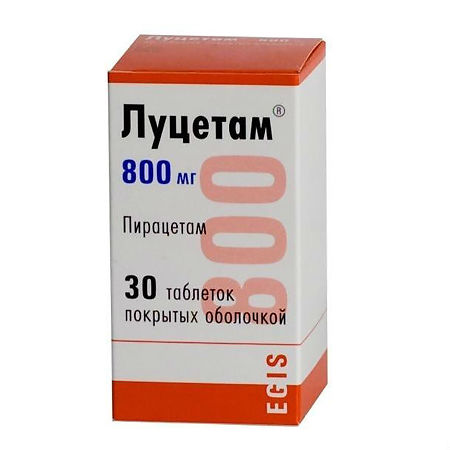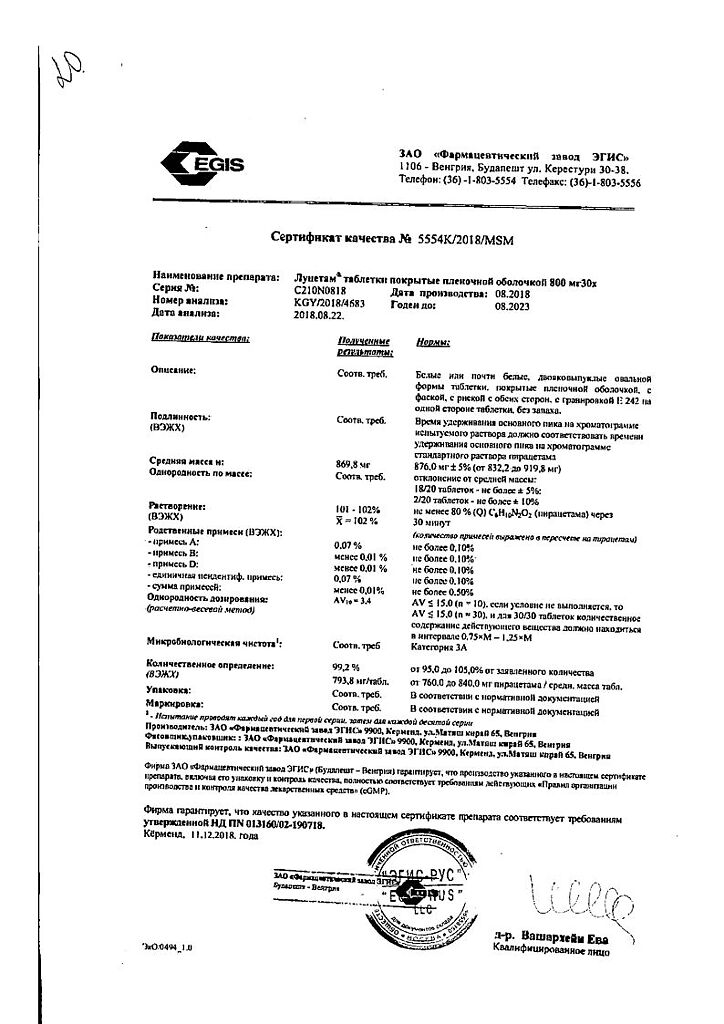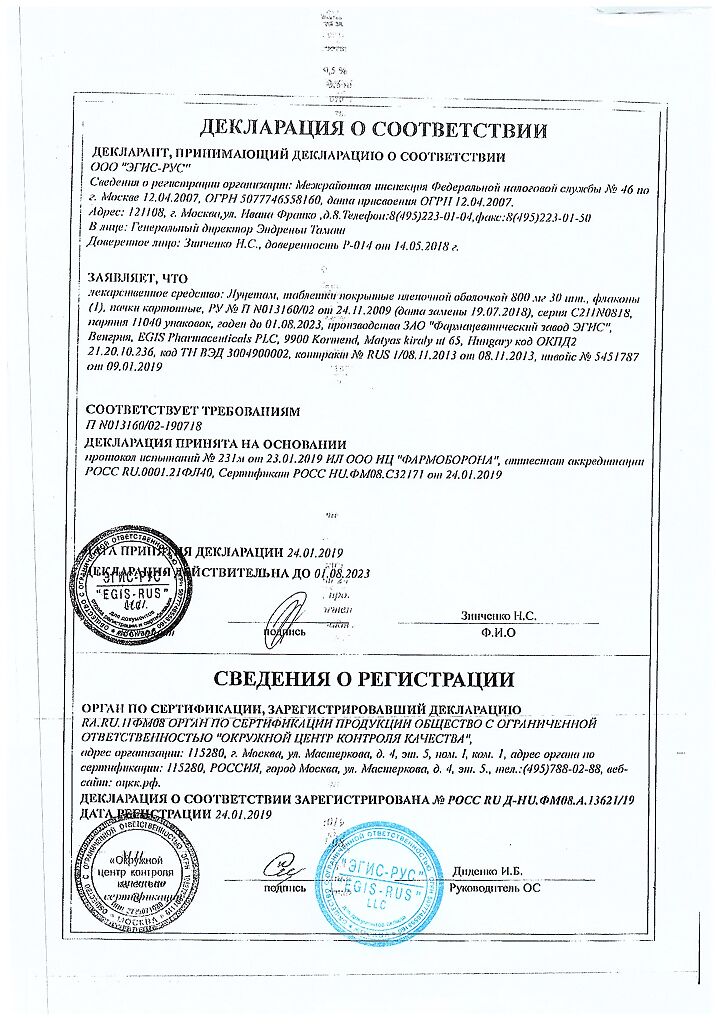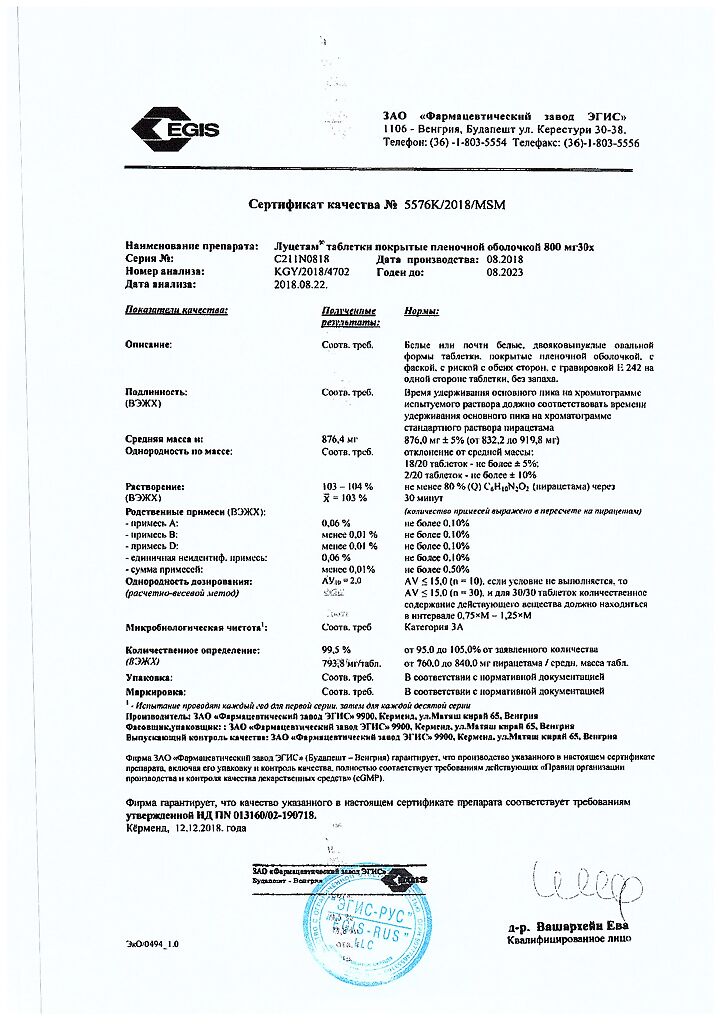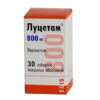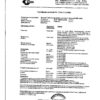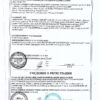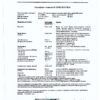No products in the cart.
Lucetam, 800 mg 30 pcs.
€1.00
Out of stock
(E-mail when Stock is available)
Description
Pharmacotherapeutic group: nootropic agent
ATX code: [N06BX03].
Pharmacodynamics
Piracetam is a nootropic that affects the central nervous system in different ways: it modifies neurotransmission in the brain, improves conditions that promote neuronal plasticity, improves microcirculation, affecting blood rheological characteristics without causing vasodilation.
Administration of piracetam in patients with cerebral dysfunction increases attention concentration and improves cognitive functions, which is manifested by significant changes on the electroencephalogram (increased α and β activity, reduced δ activity).
It helps to restore cognitive function due to various disorders such as hypoxia, intoxication or electroconvulsive therapy. Reduces the duration of induced vestibular neuronitis. Piracetam inhibits increased aggregation of activated platelets and, in case of pathological erythrocyte stiffness, improves their deformability and filtration capacity.
Pharmacokinetics
Absorption.
After oral administration, piracetam is rapidly and almost completely absorbed from the gastrointestinal tract. Bioavailability is about 100%. After a single dose of 2 g, maximum concentration (Cmax) is reached within 30 minutes and is 40-60 mcg/ml, after 2-8 hours it is detected in cerebrospinal fluid.
Distribution
The volume of distribution (Vd) is about 0.6 l/kg. It does not bind with plasma proteins. Piracetam penetrates through the blood-brain and placental barriers, as well as hemodialysis membranes. In animal studies it was found that piracetam selectively accumulates in the tissues of the cerebral cortex, mainly in the frontal, parietal and occipital lobes, in the cerebellum and basal nuclei.
Biotransformation
It is not metabolized.
Elimination
The elimination half-life (T1/2) from blood is 4-5 h and 8.5 h for cerebrospinal fluid. T1/2 is prolonged in renal insufficiency. It is excreted unchanged by the kidneys. Renal excretion is almost complete (>95%) within 30 hours. Total clearance of piracetam in healthy volunteers is 86 ml/min.
Indications
Indications
Mitigation of cortical myoclonias in piracetam-sensitive patients both as monotherapy and as part of complex therapy. (In order to determine the sensitivity to piracetam in a particular case, a trial course of treatment may be conducted.
Active ingredient
Active ingredient
Composition
Composition
1 film-coated tablet contains:
the active substance:
piracetam – 800 mg,
excipients:
magnesium stearate 6mg,
povidone K-30 50mg;
shell:
dibutylsebacate 1.4 mg,
ethylcellulose (in the form of aqueous dispersion) 7 mg,
Opadray white (macrogol 6000 – 00.5 mg, titanium dioxide – 1.5 mg, talc – 2 mg, hypromellose – 7.6 mg).
How to take, the dosage
How to take, the dosage
The drug is administered by mouth in a daily dose of 30-160 mg/kg, 2-4 times a day.
Lucetam tablets are taken with a meal or on an empty stomach with fluids (water, juice).
In symptomatic treatment of chronic psychorganic syndrome 1.2-2.4 g/day is prescribed depending on the severity of symptoms, and for the first week – 4.8 g/day.
In treatment of the consequences of stroke 4.8 g/day is prescribed.
In case of alcohol withdrawal syndrome – 12 g/day. Maintenance dose is 2.4 g/day.
For treatment of dizziness and related balance disorders 2.4-4.8 g/day are prescribed.
For cortical myoclonias, treatment begins with a dose of 7.2 g/day; every 3-4 days the dose is increased by 4.8 g/day until a maximum dose of 24 g/day is reached. Treatment is continued throughout the duration of the disease. Every 6 months an attempt should be made to reduce the dose or cancel the drug, gradually reducing the dose by 1.2 g every 2 days in order to prevent seizure. If there is no effect or little therapeutic effect, treatment should be discontinued.
In children for correction of learning disabilities, the drug is administered orally at a dose of 3.2 g/day. Treatment continues throughout the school year.
In patients with hepatic impairment no dosage adjustment is required.
In patients with impaired renal function, dosage regimen adjustment is required depending on creatinine clearance (CK). Grade of renal insufficiency CK (ml/min) Dose Normal > 80 Normal dose Mild 50-79 2/3 of normal dose in 2 – 3 doses Moderate 30-49 1/3 of normal dose in 2 doses Severe < 30 1/6 of normal dose, single dose Terminal stage – contraindicated
In patients with renal impairment/p>
In elderly patients the dose is corrected in the presence of renal insufficiency and in case of long-term therapy it is necessary to control renal function.
Interaction
Interaction
Special Instructions
Special Instructions
Due to the effect of Piracetam on platelet aggregation, caution should be exercised when prescribing the drug in patients with impaired hemostasis, during major surgery or in patients with symptoms of severe bleeding.
In the treatment of cortical myoclonias, abrupt interruption of treatment should be avoided, which may cause recurrence of seizures.
In long-term therapy in elderly patients, regular monitoring of renal function parameters is recommended; if necessary, dose adjustments are made depending on the results of CK tests.
It penetrates through the filter membranes of hemodialysis machines.
Impact on driving and operating machinery
With due regard to possible side effects, the patient should exercise caution when driving and operating machinery.
Contraindications
Contraindications
With caution
Hemostasis disorders, major surgical interventions, severe bleeding, chronic renal failure (when creatinine clearance (CK) is 20-80 ml/min).
Side effects
Side effects
Nervous system disorders: hyperkinesias, irritability, somnolence, depression, asthenia: these symptoms occur more frequently in elderly patients receiving doses over 2.4 g/day, in most cases it is possible to achieve regression of such symptoms by reducing the drug dose. Headache, dizziness, insomnia, mental agitation, restlessness, balance disorders, tremor, ataxia, worsening of epilepsy, anxiety, hallucinations, confusion, increased libido.
Blood and lymphatic disorders: bleeding
Immune system disorders: hypersensitivity, including anaphylaxis
Hearing and labyrinth disorders: Dizziness (vertigo)
Cardiovascular system disorders: decreased or increased blood pressure.
Digestive system disorders: nausea, vomiting, diarrhea, abdominal pain, epigastric pain.
Metabolic and nutrition disorders: weight gain.
Skin disorders: dermatitis, itching, urticaria.
Allergic reactions: angioedema.
General disorders and disorders at the injection site: pain at the injection site, thrombophlebitis, hyperthermia.
Overdose
Overdose
Treatment: Gastric lavage or induced vomiting may be performed immediately after ingestion. Conduct symptomatic therapy, which may include hemodialysis.
There is no specific antidote. The effectiveness of hemodialysis for piracetam is 50-60%.
Pregnancy use
Pregnancy use
There have been no studies on pregnant women, so piracetam should not be prescribed during pregnancy.
Piracetam passes through the placental barrier and into the breast milk. If it is necessary to use the drug, breastfeeding should be stopped.
Similarities
Similarities
Additional information
| Shelf life | 5 years |
|---|---|
| Conditions of storage | At 15-30 °C |
| Manufacturer | EGIS, Hungary |
| Medication form | pills |
| Brand | EGIS |
Related products
Buy Lucetam, 800 mg 30 pcs. with delivery to USA, UK, Europe and over 120 other countries.

